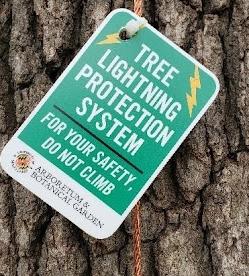You may have noticed two things if you are around Morrill Quad on campus. First, it can be a bit of a hike making your way up the hill (Morrill Quad is at one of the higher elevations on campus). Second, it’s where many of the Arboretum’s larger white oak specimens are. In an effort to protect these historic trees from being a target for damaging lightning strikes, we have been installing and updating the lightning protection systems in them.
Trees are damaged by the high heat generated by a lightning strike. Sometimes, they can take several years to show any significant health issues from the burns caused by a strike. Other times, the tree can spectacularly shatter or explode. This is due to the sap contained within the tree superheating into steam and rapidly expanding.

There has also been some research into which species of trees are most frequently struck by lightning in a mixed stand. Based on surveys, oaks in particular seem to be struck more often as are tulip poplars, ash, and certain species of pine. A few years ago, we had to remove a very large white oak (Quercus alba) on Morrill Quad following a strike.
 A lightning protection system on a tree follows the same principles as one that you would find on a building. A lightning rod (which arborists call an air terminal) is installed at the highest point of the tree. Depending on the size of the tree, more than one may need to be installed. These air terminals are then attached to a copper cable, which runs down the side of the tree. This cable is held away from the trunk with a series of pins, and it eventually runs underground through a trench that extends out to the drip line of the tree. Finally, the conductor is attached to a large grounding rod that has been hammered into the ground.
A lightning protection system on a tree follows the same principles as one that you would find on a building. A lightning rod (which arborists call an air terminal) is installed at the highest point of the tree. Depending on the size of the tree, more than one may need to be installed. These air terminals are then attached to a copper cable, which runs down the side of the tree. This cable is held away from the trunk with a series of pins, and it eventually runs underground through a trench that extends out to the drip line of the tree. Finally, the conductor is attached to a large grounding rod that has been hammered into the ground.
The purpose of this system is to give the lightning a path of least resistance away from the tree. It’s important to note that this does not prevent the tree from being struck in the first place, which is again why you should never take shelter under a tree during a thunderstorm.
Because a tree continues to extend upward and outward as it grows, a lightning protection system must be evaluated periodically to see if any adjustments must be made. Should the tree grow over any section of the system, it no longer provides protection.
 We have also attached signs on the systems to discourage anyone from trying to climb the tree using the cable. This would lead to the connector pins being ripped out of the tree and may also lead to injury. These signs will probably melt when a lightning strike occurs, but that’ll let us know the system is working!
We have also attached signs on the systems to discourage anyone from trying to climb the tree using the cable. This would lead to the connector pins being ripped out of the tree and may also lead to injury. These signs will probably melt when a lightning strike occurs, but that’ll let us know the system is working!
